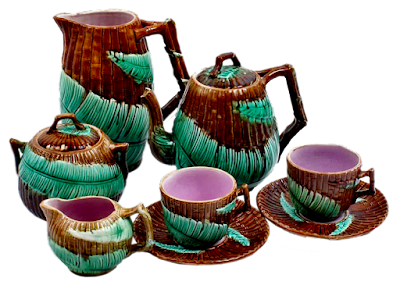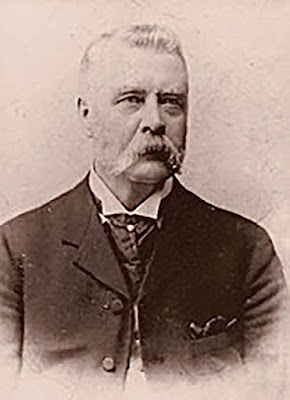Wardle Ocean majolica platter
Wardle & Co. majolica hand vase
Founder James Wardle was born in 1823. Apprenticed as a potter in his youth under his potter father, he soon advanced to a modeler in the Staffordshire potteries. At the age of 31 he opened a small plant in Hanley. In 1859 he decided to form a partnership with George Ash in Hanley. They specialized in decorative pottery. After an uneventful six years the partnership dissolved and Wardle struck out on his own operating under the name James Wardle. In 1865 he began the production of majolica. Unfortunately his company declared bankruptcy the following year and all production ceased. He reorganized and began another pottery under the same name in 1867.
Wardle trade ad from 1867
His output of decorative pottery, including majolica, continued for the next five years, registering several designs for majolica use. He recognized the interest in decorative pottery abroad and began exporting majolica to expand his customer base.
Early Wardle majolica corn hand vase
James Wardle’s unexpected death in 1871 forced his wife Eliza into the unusual situation of owning and operating a pottery. She entered into a partnership with Joshua Seddon —a man believed to have been employed as a manager in her husband’s pottery— to assist in running the pottery. Eliza remained chief operator until 1876 when Seddon left the partnership.
After Seddon departed, the business officially reverted to Wardle & Co. and Eliza took on complete ownership of the company. The business received an injection of capital in 1882 by entering into a partnership with David Jones, the husband of her daughter Sarah. The company increased its output under this partnership and entered its most prolific period. Wardle and Jones enlarged the size of the pottery by expanding to the newly opened Washington Works Pottery.
Wardle's Washington Works Pottery
It was during this period that Wardle & Co. produced its most successful patterns: Bamboo & Fern, Pineapple, Sunflower, Blackberry, Chrysanthemum, Fan, water lily, and Ocean. All of these were heavily influenced by the Aesthetic Movement, then in vogue. Eliza expanded on her husband’s export strategy by shipping huge amounts of majolica to the expanding middle class market in the United States.
Wardle & Co. trade advertisement from 1885
One of Wardle’s earliest registered designs is the Monkey Chestnut Dish.
Wardle majolica monkey dish
They also made a squirrel nut dish using the same design.
Wardle majolica squirrel dish
Another registered design, the Bamboo & Fern tea set is very popular with majolica collectors. Made in four different color grounds, brown, yellow, grey and turquoise, it is easily found today. You can see our special post on this pattern here.
Wardle Bamboo & Fern tea set
One of the most frequently seen Wardle patterns is their Fan design. It uses Japanese iconography in a very Western way.
Wardle majolica Fan tea set
Wardle Fan can be seen in the genre paintings of L.C. Moeller which adds context to our appreciation of the pattern.
One of the loveliest patterns made by the company is Ocean. Copied by other potteries, including the Arsenal Pottery in America, the Wardle pieces usually have brighter, better defined color.
Wardle majolica Ocean tea set
Compare Wardle’s version of the Ocean jug with the Arsenal Pottery version below it.
Wardle Ocean majolica jug.
A pattern created during the peak of Oscar Wilde’s influence during the Aesthetic Movement is Sunflower which incorporates the two flowers most closely associated with Wilde, the sunflower and the lily.
Wardle Sunflower platter
Another often seen pattern is Wardle’s Chrysanthemum.
Wardle & Co. Chrysanthemum platter
A pattern usually attributed to Samuel Lear’s pottery but made by Wardle as well is water lily.
Wardle/Lear water lily tea set
The only registered Wardle pattern I know of that was marked with a pattern name is Woodbound. It’s not a commonly found pattern and may have been created exclusively for the American consumer.
Wardle Woodbound majolica teapot
This unnamed registered pattern by Wardle is a floral and basketweave themed one.
Wardle floral and basketweave teapot
Wardle Apple Blossom majolica teapot
Similar to the Adams & Bromley Pineapple series, Wardle did a very successful Pineapple grouping as well.
Pineapple teapot attributed to Wardle
An example of another typical Wardle pattern showing a crane.
Wardle majolica crane jug
An unusual jug Wardle created for the American market was a memorial piece for the 1881 assassination of President Garfield.
Wardle made things besides tableware such as garden wares.
Wardle President Garfield memorial jug
Wardle majolica bear jardiniere
Wardle majolica jardiniere
Wardle majolica basket
Wardle majolica grape tray
Wardle majolica ocean jug
Wardle majolica swan vase
Majolica production continued as the company began to incorporate simpler and less elaborate two color and monochromatic wares into its line. Late Wardle pieces included many with simplified color such as the garden pieces below.
"Wardle England" majolica garden seat
Wardle and Jones ran the pottery jointly until Eliza’s death in 1889 at which time Eliza's sons William and Frederick joined David Jones to assume ownership of the pottery. The company continued expanding its line of wares incorporating barbotine decorated ware for which they became well known, sand majolica—called moss ware—and simple utilitarian ware. Beginning in 1891 Wardle majolica was marked "Wardle England."
Wardle & Co. barbotine sand vase, also called Moss ware
By 1900 both Wardle sons left the partnership and Jones assumed management of the pottery with a partnership of several investors. In 1903 Jones developed financial difficulties and restructured the company under the name Wardle & Co. Ltd. enlarging production of art pottery in response to changing tastes but still continuing some majolica wares.
Wardle copy of a Sarreguemines character jug
"Wardle England" turn-of-the-century vegetable themed jug
Jardiniere and pedestal marked Wardle & Co. Ltd.
After Jone’s death in 1908 the company was dissolved and what remained was purchased by Robinson & Sons, Ltd. In 1909 the pottery was moved to the Wolf Street Works and operated under the name of Wardle Art Pottery. They produced art pottery as well as a variety of other wares. It was eventually absorbed by the Cauldon Pottery who kept it in operation at Wolf Street until 1935 when Wardle Art Pottery was dissolved.
Most earlier 19th century Wardle majolica is unmarked but their later work generally was. They used a variety of different marks, some shown below.
One of the more interesting aspects of Wardle & Co. is that it was a springboard for other famous potters. Manufacturer Thomas Forester worked for the company until 1875 and later left to open his own pottery making majolica. Pottery designer Charlotte Rhead began her career at Wardle & Co. Ltd. in 1903. Frederick Hurten Rhead, Charlotte’s brother and a major potter of the Arts & Crafts and Art Deco period, also designed work for Wardle Art Pottery.
Thomas Forester
Charlotte Rhead
Today Wardle is easily within the budget of most collectors. A fine collection of examples displayed together would make a striking display for minimal investment with their bright but similar color palette tying together pieces from separate patterns…
… and we a have a woman, Eliza Wardle, who saved her husband’s company and created the firm’s most memorable patterns, to credit for this.










































































No comments:
Post a Comment